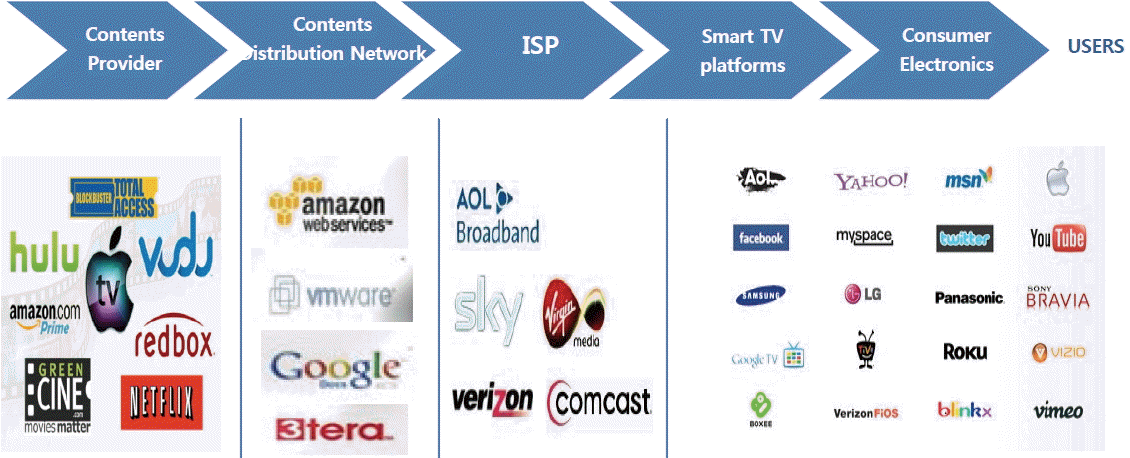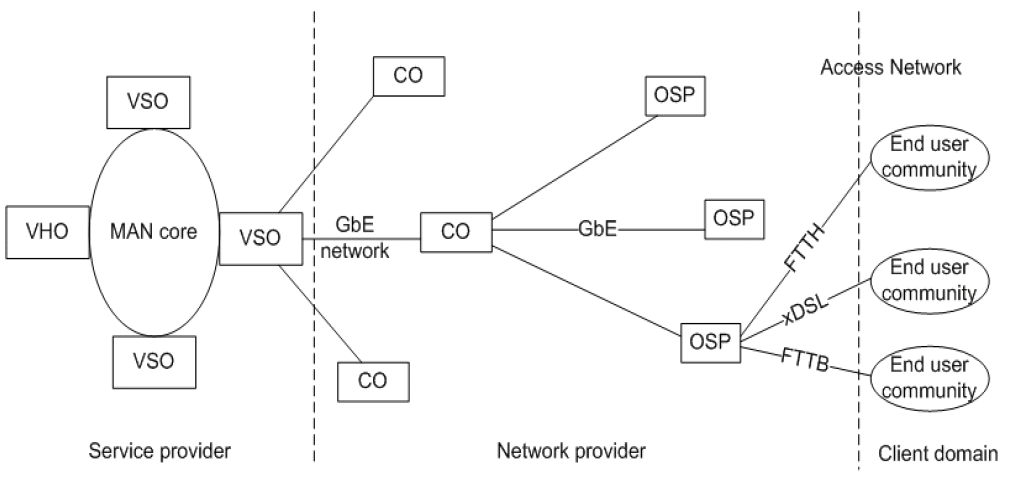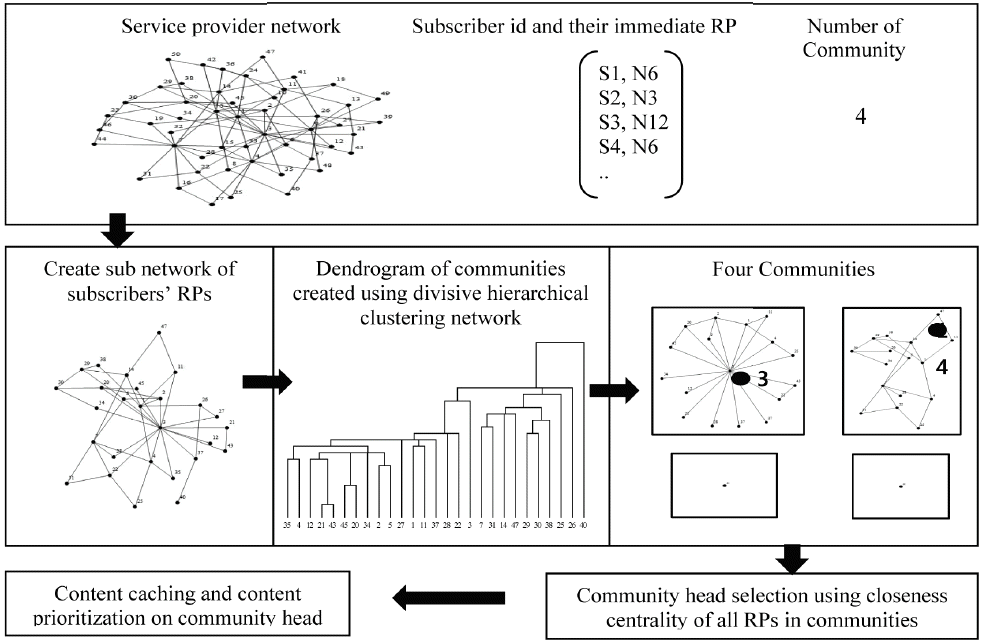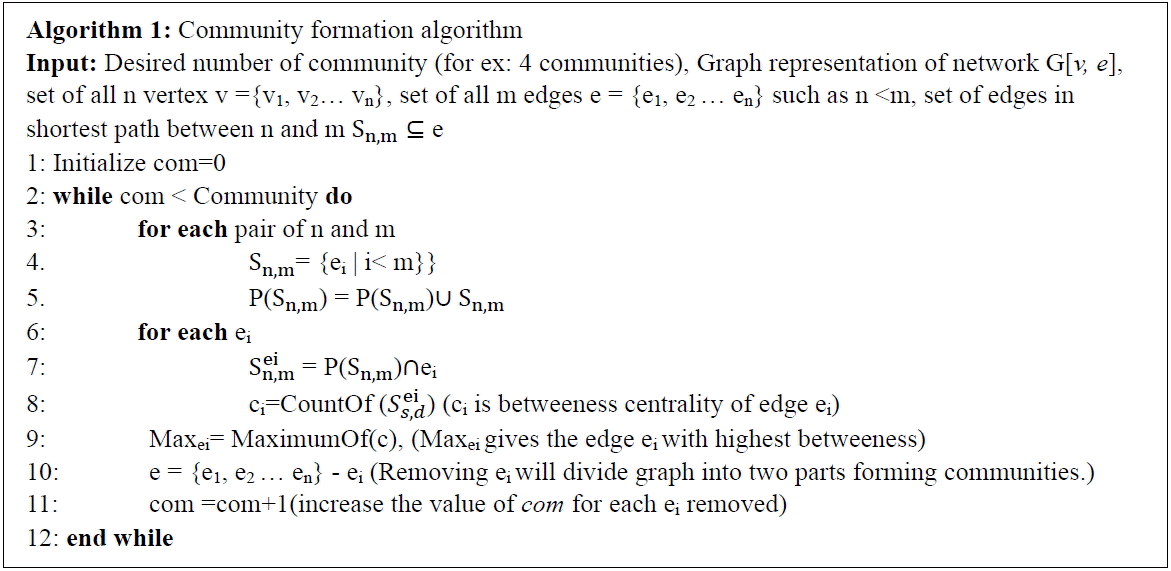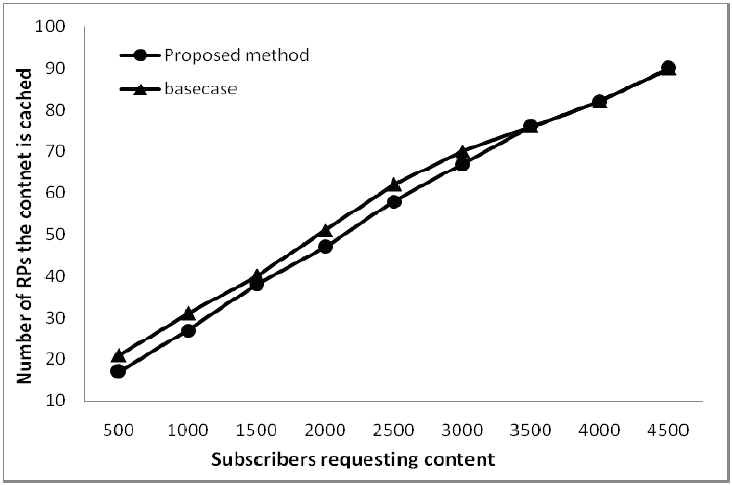Community Model for Smart TV over the Top Services
Article information
Abstract
We studied the current state-of-the-art of Smart TV, the challenges and the drawbacks. Mainly we discussed the lack of end-to-end solution. We then illustrated the differences between Smart TV and IPTV from network service provider point of view. Unlike IPTV, viewer of Smart TV’s over-the-top (OTT) services could be global, such as foreign nationals in a country or viewers having special viewing preferences. Those viewers are sparsely distributed. The existing TV service deployment models over Internet are not suitable for such viewers as they are based on content popularity, hence we propose a community based service deployment methodology with proactive content caching on rendezvous points (RPs). In our proposal, RPs are intermediate nodes responsible for caching routing and decision making. The viewer’s community formation is based on geographical locations and similarity of their interests. The idea of using context information to do proactive caching is itself not new, but we combined this with “in network caching” mechanism of content centric network (CCN) architecture. We gauge the performance improvement achieved by a community model. The result shows that when the total numbers of requests are same; our model can have significantly better performance, especially for sparsely distributed communities.
1. Introduction
TV services have evolved from free-to-air broadcast TV to Smart TV in past 50 years. Historically free-to-air TV evolved into cable TV and then to IPTV, and now the new phenomenon of TV exposed in market is called Smart TV.
Sometimes, Smart TV is referred to as Connected TV or Hybrid TV. These are the phrases used to describe the current trend of integration of the Internet and Web2.0 features into modern television sets and set-top boxes. These new TV will have higher focus on online interactive media, Internet TV, over-the- top (OTT) content, as well as on-demand streaming media, and less focus on traditional broadcast.
Broadcasters owned television historically. The broadcast TV (free-to-air TV) has old generation of viewers, hence, it will remain around even if the TV market is being revolutionized through Smart TV, however it might become merely an application in Smart TV.
After broadcasters, appeared Cable TV providers, who offered hundreds of channels. In future, it will be possible to buy channels independently using Smart TV and broadband connection. So we will not need to buy the bunch of channel provided by broadcasters, rather we can buy the channels which we would like to watch.
Cable TV revolution was soon followed by Internet revolutionized TV experience by offering Web TV, which is still very popular among youngsters, however integrating it with the present free-to-air TV systems would be revolutionary.
Next IPTV model was introduced a few years ago in the market, which was mainly owned by Internet service providers.
At present, the revolutionary Smart TV is offering integration for Internet and TV services with social networking and online gaming facilities. Moreover, it will also offer great Video On Demand services and various types of applications similar to smart phone. The key of success of Smart TV is contents and applications.
TV has evolved and revolutionized. There are several Smart TV initiatives driven by different market players. The key players in Smart TV market include OTT service providers, CDN and ISP/Telecom, Consumer Electronics as shown in Fig. 1. Each of these key players has their own initiatives and views towards Smart TV, and there is lack of end-to-end solution.
In this paper, we analyzed various initiatives and studied their standardization activity. Smart TV services would be deployed on existing Internet infrastructure and communities will be global, hence this work simulated Smart TV service deployment scenario for global communities over Internet. This paper proposes a community formation model and location identification mechanism for caching contents. We combined the proactive caching with “in network caching” [1,2] mechanism. We compared our proposed method with the base-case scenario that is caching without community.
This paper is broadly divided into two parts: the first part surveys the current state-of-the-art of Smart TV and the second part proposes a community based method for service delivery.
The remainder of the paper is as follows. Section 2 describes different market players in Smart TV market space and lack of end-to-end solution. It also explains and compares the standardization activities of Smart TV. Section 3 explains the proposed method and describes the community formation methodology. Section 4 provides the simulation mechanism and discusses the results and Section 5 concludes the findings and provides future work.
2. Current State of Art
2.1 Lack of End-to-End Solution
The key players in Smart TV market include content-and-service providers, CDN-and-ISP/Telecom, and consumer electronics as shown in Fig. 1.
Content and service providers are mainly OTT, virtual multiple system operator (MSO), application and game developers or broadcasters. Virtual MSO model, or online cable company model is based on the bundling of TV channels and delivering them to consumer over the Internet without any geographic restrictions that confine traditional cable operators. Virtual MSOs can be categorized in the following categories.
Netflix, Amazon, and Hulu: They have taken existing and back cataloged content and bundled it into new low cost packages over the Internet.
Google YouTube and Apple iTune: They have created content for distribution where consumers do not have to go through a cable company. In its present form, Google TV and Apple TV is a method of organizing content from a central OS in your TV using the Android and iOS operating system, respectively.
Broadcasters (such as ESPN, Disney, and HBO): They are broadcasters directly supporting Smart TV concepts. As an example, the entire HBO catalog is available on Roku (device to stream content in TV) through authentication, or through a “TV Everywhere” subscription.
Other key players in Smart TV market are CDNs, ISPs, and Clouds. The MSOs, OTTs, and broadcasters have plentiful of contents, however they use third party’s infrastructure, rather than their own, to deliver services. CDNs, ISPs, and Clouds have the potential to provide these services. The main job of CDN and ISPs includes: 1) enhance QoS and QoE for subscriber, 2) traffic management and optimization, 3) provide Service Level Agreements (SLA), and 4) provide cloud base platforms.
Equally important player in Smart TV market are consumer electronics and Smart TV platform developers. Main contribution of consumer electronics companies would be to develop platform for Smart TV services. Companies such as Google provides their legacy search engine, browser and android platform for Smart TVs. Some of the consumer electronics companies have their own platforms such as Hulu and Roku, etc., however some companies including LG, Toshiba, and Panasonic are contributing to build an open platform through Smart TV alliance [3].
We saw there are various key players in Smart TV market but there is a lack of end-to-end solution. Each of these key players is trying to standardize the Smart TV initiatives and lack a common goal.
2.2 Smart TV Standardization
The researchers in academia and the industry are using various key terminologies to refer to TV services, such as IPTV, HbbTV, Smart TV, etc. The key difference in these keywords is that they are different initiatives taken by different key players in TV market to standardize TV services. IPTV is an ISP and Telecom driven approach; however Smart TV is customer electronics driven approach for TV viewing. HbbTV is European initiative for Smart TV and it is driven by broadcasters and cable companies as shown in Table 1.
ISP driven IPTV model is mostly broadband owned television services model that uses Internet protocol suite for services delivery. ITU-T defines IPTV as multimedia streaming over IP networks with reasonable quality assurance [4]. A typical IPTV network is composed of super headend (SHE) and video hub offices (VHOs) at the national core. VHOs are connected to multiple video source servers (VSOs) which constitute the metropolitan area network (MAN) core, and VSOs are connected to central offices (COs) which are closer to the user communities. VSOs’ edge routers route and aggregate local loop traffic from passive optical networks (PONs) area networks or from digital subscriber line access multiplexers (DSLAMs). DSLAMs and PON support Gigabit Ethernet transport networks. There are video on demand (VoD) servers at each of these hierarchical levels. The contents are distributed over the VoD servers at each level of hierarchy of VSO, VHO, and CO as shown in Fig. 2. OIPF, ETSI TISPAN, ITU-T NGN, ATIS IIF standardize IPTV platform services and networks [4]. The drawback with IPTV is that the contents and services provided are only ISP subscribed and are provided in fixed network architecture composed SHEs, VHOs, VSOs and COs; hence, it does not utilize the open nature of Internet.
Consumer electronics driven Smart TV initiative focuses on standardizing the Smart TV application framework, such as Smart TV alliance [5] standards for app development, HTML5 SDK, multi-screen support standards, HTML 5 based smart homes etc. Smart TV alliance focus on app development for all kinds of OS including Google’s Android and Apples iOS.
HbbTV standards [7] provide consumers with a seamless entertainment experience combining with richness of broadcast and broadband. The basic difference between Smart TV initiative taken by consumer electronics, Google TV, IP and HbbTV is that HbbTV standard harmonizes the traditional broadcast video delivery with the IPTV and broadband services. In general, all connected TV sets have two inputs: one for the broadcast signal (TV tuner) and one for the Internet (Ethernet/WLAN) connection, they do not necessarily offer converged services by making use of both distribution paths. This cannot be considered as converged services; for the truly hybrid services enabling a seamless user experience, an “engine” is required that links the broadcast content offered via the CATV network and the Internet content offered via the interaction channel, be it via Ethernet on DSL or via Ethernet on CATV—or via any other IP connection. HbbTV provides such an engine. The HbbTV specification is based on elements of existing standards and web technologies including OIPF (Open IPTV Forum) [6], CEA-2014 (CE-HTML) [9], W3C (HTML, etc.), and DVB application signaling specification (ETSI TS 102 809) [3].
3. Proposed Method
Whether it is Smart TV, HbbTV or IPTV, they all use IP based content delivery, either on best-effort Internet, on hybrid-Internet-broadcast network or on private IP network. Hence, in this paper we simulated Smart TV network as Internet. The network is viewed as a graph of nodes and edges that follows a power-law distribution [10].
Moreover, we focused on providing these services to the communities that are sparsely distributed. A community here is defined as a group of subscribers sharing similar characteristics, such as similar subscriptions and proximity space. The sparsely distributed communities over Internet could be 1) community of foreigners subscribed to the consents from their native countries; 2) community of people subscribed to specific languages, or translation services; 3) community of disabled subscribed to sign language services; and 4) community of people having special interests in certain type of contents. The current trend of globalization is increasing the scenario of global communities distributed all over the world. Content caching for such communities firstly require proper identification of such communities and secondly caching content at appropriate location.
We require the metrics provided by service providers including the network topology, the list of subscriber and the last mile RP to which each subscriber is connected and the number of communities to be formed. RP is defined as the nodes responsible for routing, forwarding, and caching contents. After receiving these metrics, firstly a connected network topology of the subscribers is created. If the subscribers are sparsely distributed, some intermediate RPs are included in network topology in order to make a connected network of subscriber. Then, divisive-hierarchical-clustering algorithm is applied to form subscriber communities. Next, community head is selected using closeness-centrality approach. The community heads are the nodes where service provider would cache the contents. After copying the contents to the community head their priority is set to higher priority, so it can remain in cache. The overall algorithm is explained in Fig. 3.
3.1 Community Formation
Community detection is a well-known problem in the field of machine learning [11,12]. The same ideas could be adopted in finding community of Smart TV application viewers as well. We used Girvan– Newman [13] method of community detection, which is popularly known as divisive-hierarchical-clustering. The method is explained in Algorithm 1. The method calculates the betweenness of all edges to create communities. Betweenness is a measure of flow that the edge carries. Then removes the one with the highest betweenness. It removes multiple edges, if there is a tie, (step 10 in Fig. 4). This will cause a graph to separate into multiple components resulting into creating communities. Then recalculates the betweenness of the remaining edges. The process is repeated until the desired numbers of communities are found. As a result, a dendrogram is generated as shown in Fig. 5.
This method has several benefits compared to agglomerative hierarchical clustering or k-mean clustering [12] in community detection. As the Girvan–Newman algorithm runs, the dendrogram is produced from the top down (i.e., the network splits up into different communities with the successive removal of links). The bottom-up approach followed in the agglomerative hierarchical clustering or k-mean methods make clustering decisions based on local patterns without initially taking into account the global distribution. The leaves of the dendrogram are individual nodes. However, top-down clustering benefits from complete information about the global distribution when making top-level partitioning decisions. This clustering approach can be stopped at any iteration depending on the number of communities we want to make; hence, there is no need to go till the bottom of the dendrogram formation. The sample dendrogram for community formation is shown in Fig. 5. If the desired number of community is four the algorithm would stop at second iteration itself, hence forming four communities for 27 rendezvous points (RP).
3.2 Community Head Selection
After the formation of community, the community head is selected. RP selected as community head would be candidate for content copying. The community head will have greater access to information and can deliver the content to others more efficiently. The most common and efficient approach for community head selection is based on centrality. There are four main measures of centrality: degree, betweenness, closeness, and eigenvector [13]. Generally, these centrality types will be positively correlated. We use distance based centrality measure that is closeness centrality. The closeness centrality of a RP i is defined as the inverse of the sum of the distance from i to all other RPs as shown in Eq. (1). Here n denotes total number of RP, d(i, j) denotes the distance of i from j. N14 and N3 are selected as the community head as shown in Fig. 6, based on the closeness centrality for two of the communities as the result of dendrogram in Fig. 5.
3.3. Related Work
The previous studies have considered content popularity for service deployment [14,15]. In those approaches, content caching is based on popularity of content. Differing to that, our proposal is based on community formation. There are two main advantages in our proposal: 1) it is possible to detect communities that are not densely distributed in access networks but require good quality of services. Content popularity based approach cannot serve such communities well. 2) Community based approach does not necessarily need the content caching on the leaf nodes as copying content to the edge is not always a suitable solution especially if the user community is sparsely distributed.
In this paper, we chose the well-established community formation model based on divisive-hierarchical- clustering [13] to form community. This method has several benefits compared to agglomerative hierarchical clustering or k-mean clustering [12]. Top-down clustering approach taken in this paper considers global distribution when making top-level partitioning decisions and can be stopped at any iteration depending on the number of communities we want to make.
There has been several [16–18] research proposing caching mechanisms for web services. Our approach differs from them as we took advantage of latest content centric network and incorporated “in-network-caching” mechanism with proactive caching. Our test results also compared the base-case scenario of in-network-caching with the proposed method where we combined in-network-caching with proactive cashing. The results have shown significant reduction of number of replicas for sparsely distributed communities.
4. Performance Evaluation
4.1 Simulation Environment
For performance evaluation with simulations, we made the following assumptions regarding network topology, delivery mechanism, and routing protocol and caching.
Power-law distribution: We use power law distribution to generate graphs that represent network topology of service providers network. The previous studies on the Internet topology [10] have revealed that the topology of such networks closely follows a power law distribution. In our simulation, we used power law topology graphs with 10, 20, 30, 40, 50, 60, 70, 80, and 90 RPs. We assumed each RP is having 50 clients.
Publish/subscribe: We assume that service provider’s network uses Pub/Sub [19] architecture. This architecture includes publishers, subscribers and RPs. The node where the matching of a publisher’s content with a subscriber’s interest takes place is referred to as the RP. RP does routing, forwarding and distribution decisions.
In-Network-Caching: Data packets are cached everywhere along the delivery path as they may be useful to other consumers [2]. The contents are removed based on LRU. In our simulation when the packets are forwarded from source to destination, it is also cached on the intermediate RPs. This is a powerful phenomenon also utilized in future Internet architectures including CCN [1,20].
Routing: We implemented IS-IS routing algorithm on our power-law-distributed network. IS-IS uses Dijkstra’s algorithm for computing the best path through the network. Packets are then forwarded.
Mean request arrival: The request arrival is simulated as uniformly increasing distribution and then poison distribution with mean request arrival as 100, 200, 300, and 400 requests per second.
The simulation is done using Java and Mathematica.
4.2 Simulation Results and Discussion
Base-case scenario: The base-case scenario is conducted without any community. In base-case scenario, we implemented in-network-caching. The contents were copied in the intermediate RPs while delivering it. This is also an attractive property of CCN [1] architecture, if the new subscriber requests for the same content it can be found in the nearby RPs that have cached it already. However, the drawback of this approach is that, the content on intermediate RPs will also be replaced by the more popular contents based on LRU, resulting into cache miss, which will lead the subscriber up to the higher levels of RPs, where the content is available. This will result into higher traffic in network and recopying the content on the intermediate RPs.
With Community: In this scenario, in-network-caching is combined with the community head selection and caching. In this case, when publisher is ready to provide the requested content, the content is made available to all the community heads and content-priority is set to higher values, so that such content will remain on the community head for longer period of time. Due to the LRU algorithm the content entry will expire from the other RPs, however it will be available on the community head. This method shows a significant performance improvement, especially for sparsely distributed communities.
We tested these scenarios in two different sets of experiments. The first scenario simulates the uniform distribution of requests from subscribers. The second simulates dense to sparse distribution of subscribers.
For simulating uniform distribution, the service provider network and subscribers requesting content increased proportionately. With the linear increase in number of subscribers requesting content and increasing subscriber network, the number of RPs the data is copied also increases as shown in Fig. 7; however, we can see the significant improvement in proposed method. When the contents have expired and subscriber wants to access the content, which is served from community head instead of the publisher’s main server. This will also result in less traffic in network.
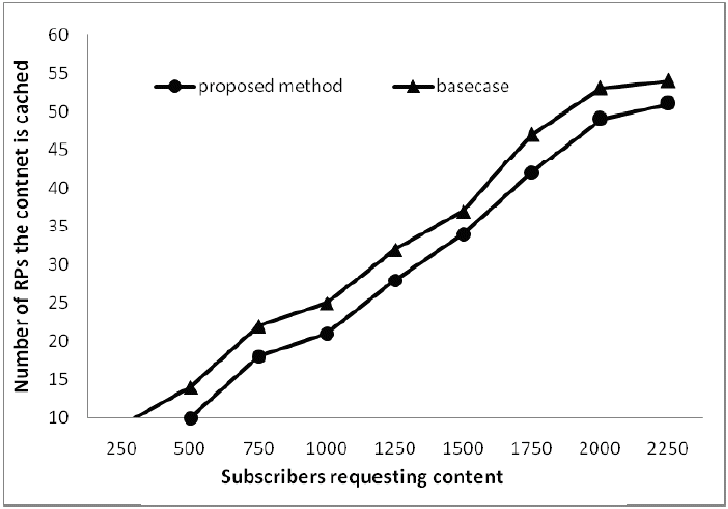
Increasing number of subscriber and increasing size of service provider network, simulating uniform distribution of request.
In Fig. 8, the service provider network size increases but the number of subscribers remain constant; hence, it simulates the scenario of dense to sparse distribution of subscriber. We observe that with increase in service provider network size the number of RPs to copy the data increases in both scenarios linearly, however the proposed method performs better. In sparse distribution, the difference of number of RPs (cache contents) in proposed method is significantly low; hence we conclude that our method is effective for sparsely distributed communities. As the subscribers’ increase both the scenarios give similar results, especially after the point when subscriber requesting contents reaches 3,500 out of 4,500 total subscribers as shown in Fig. 9. This is a saturation point. For densely distributed communities the base-case scenario of in-network-caching without community is more effective.
We also simulated with request arrival as Poisson distribution. The results shown in Fig. 10 are simulated on network of 50 RPs and 500 subscribers with mean request arrivals as 100, 200, 300, and 400 requests per minute. The proposed method could achieve significant improvement in number of RPs (cache contents) especially if the consumers are sparsely distributed as shown in Fig. 10. As the mean request arrival increases the difference between the numbers of RPs the data is copied in base case scenario and the proposed method starts to reduce. Hence, this method is mainly useful for sparsely distributed global communities such as 1) community of foreigners subscribed to contents from publishers of their countries, 2) community of people subscribed to specific language, or translation services, 3) community of disables subscribed to sign language services, 4) community of people having special interests in certain type of contents, etc.
5. Conclusion and Future Work
Smart TV can provide a great commercial opportunity for the content providers. Broadcasters can provide plentiful of contents, the Internet giant such as google can offer platforms and search engines, and through HbbTV can provide convergence of broadcast TV and broadband TV. HbbTV, Google TV, or Smart TV channels could be offering the viewer a wealth of interactive applications like programmed guides, games, visual radio, voting, tele-text with embedded graphics and video, and access to a catch-up service, etc.
To have a seamless viewing experience of these services, formation of community and caching contents on appropriate locations is the prime challenge. This paper proposes a method to form a communities and cache contents combined with in-network-caching mechanism. The proposed method is mainly beneficial for sparsely distributed communities.
In future, we will study future Internet and consider integrating our model into future Internet such as CCN and Publish/Subscribe networks.
Acknowledgement
This research was supported by Basic Science Research Program through the National Research Foundation of Korea (NRF) funded by the Ministry of Education (2014R1A1A2055463).
References
Biography
Suman Pandey

She received her M.S. degree (2009) from POSTECH and she is pursuing her Ph.D. from Kangwon National University (2015). At present, she is an assistant professor at Catholic University of Daegu, Korea.
Young Joon Won

He received his B.Math. from the University of Waterloo (2003) and Ph.D. from POSTECH (2010). He was a researcher at Internet Initiative Japan, Tokyo, Japan. Prior to IIJ, he was a postdoctoral researcher at INRIA, France. At present, he is an assistant professor at Hanyang University, Seoul, Korea.
Mi-Jung Choi

She received her B.S. degree in CS from Ewha Womans University in 1998, and M.S. and Ph.D. degrees from the Dept. of CSE at POSTECH in 2000 and 2004, respectively. She was a Post-doc fellow at INRIA, France from Oct 2004 to Sep 2005 and at School of Computer Science, University of Waterloo, Canada from Nov 2005 to Oct 2006. She was a research professor at POSTECH, Korea from Nov 2006 to Aug 2008. At present, she is an associate professor in the Department of Computer Science, Kangwon National University, Korea. Her research interests include traffic analysis using data mining techniques, and management of SDN/NFV networks and services. She is a member of the IEEE.
Joon-Min Gil

He received his B.S. and M.S. degrees in Computer Science from Korea University, Korea in 1994 and 1996, respectively. He received his Ph.D. degree in Computer Science and Engineering from Korea University, Korea in 2000. Before joining in School of Information Technology Engineering, Catholic University of Daegu, He was a senior researcher in Supercomputing Center, Korea Institute of Science and Technology Information (KISTI), Daejeon Korea from Oct 2002 to Feb 2006. From Jun 2001 to May 2002, he was a visiting research associate in the Department of Computer Science at the University of Illinois at Chicago, USA. His recent research interests include cloud computing, big data computing, distributed and parallel computing, and wireless sensor networks.
